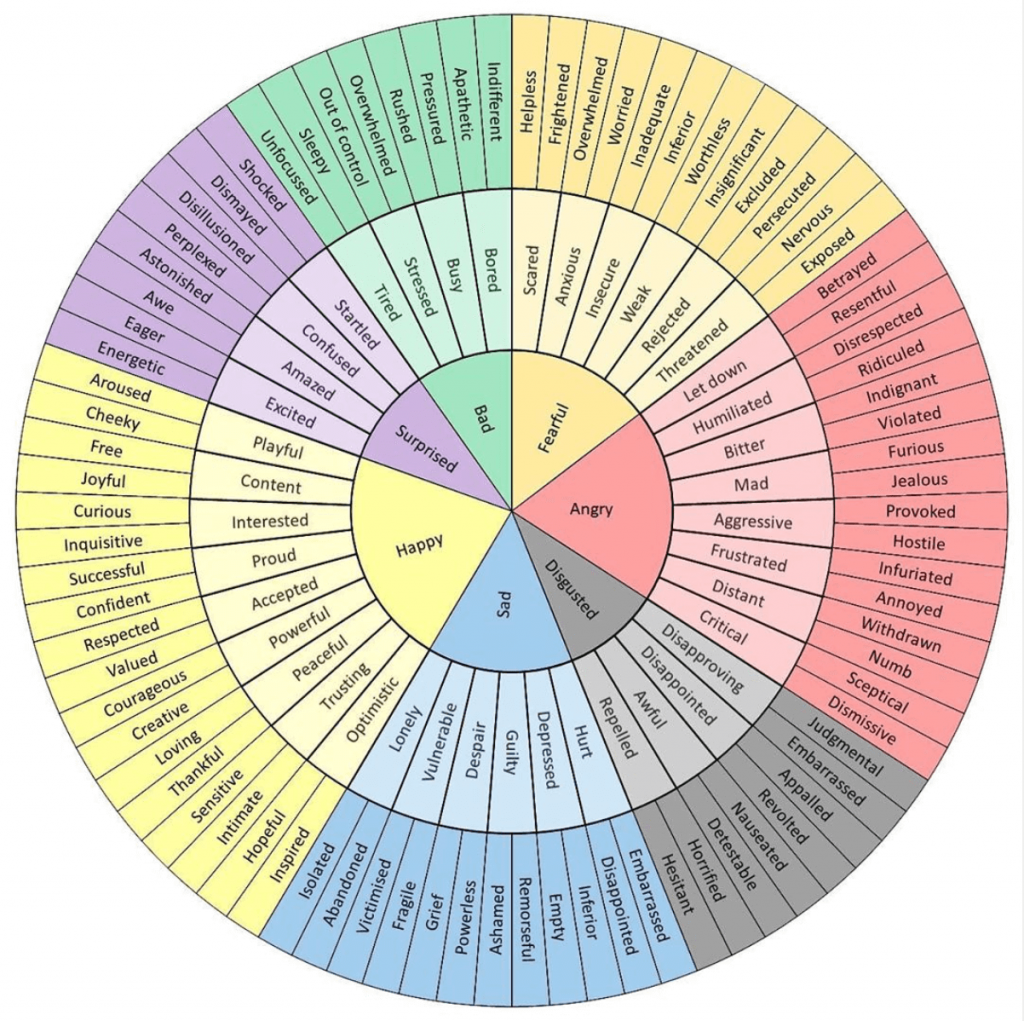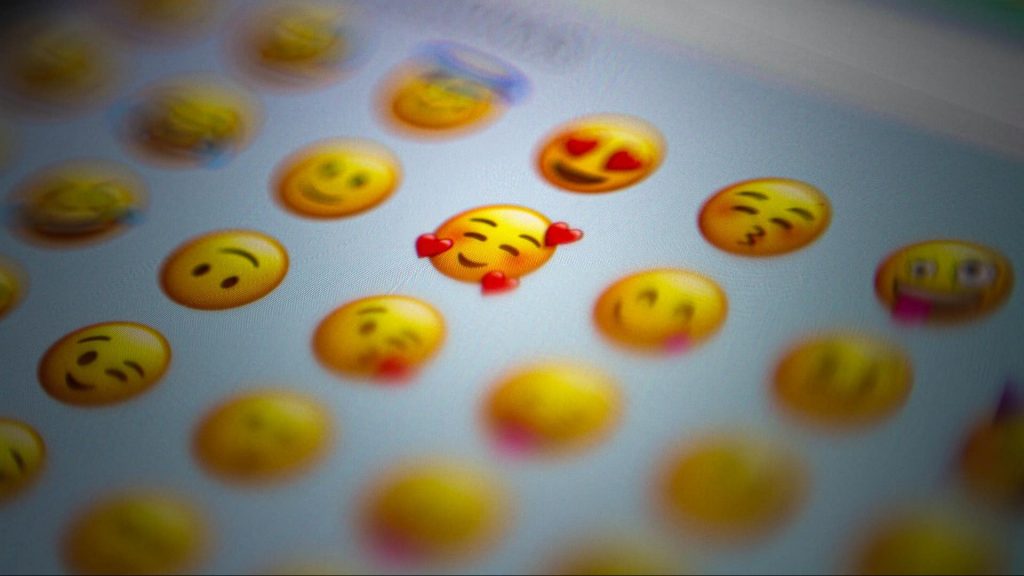Using the Wheel of Emotion to Increase Emotional Awareness
How are you? … I would guess that most would answer with a simple ‘good’, ‘fine’, ‘well’ or ‘bad’. But really, how are you? What emotion are you currently feeling? That can be a really challenging question to answer because we seem to be lacking a vast vocabulary to truly capture what we are really feeling. Or we seem to lump together a whole range of feelings under the banners of really general emotions. The solution? The Wheel of Emotion. It sounds simplistic or even silly but just stick with me for a moment.
Enter: The Wheel of Emotion

The wheel of emotions is a circular graphic that is divided into sections and then subsections to help people better identify and understand their emotional experiences. Emotional literacy – the capacity to truly understand and communicate your feelings – is a seemingly rare skill. It is becoming less and less common as technology and a very loud world steals our attention and forces us to be all-consumed by everyone else’s world that we cannot introspect and really be in tune with our own emotions and inner world. Emotional literacy is the door to awareness of self, others and surroundings, needless to say, it is an important skill! The human race can’t afford for this to be a dying skill!
There are a few kinds of emotion wheels with different designs, but all of them achieve the same thing: emotional clarity. The Geneva emotion wheel is a wheel shape but also split into four quadrants which rank emotions from pleasant to unpleasant. Then there is Plutchik’s Wheel of Emotions, which was invented and designed by psychologist Robert Platchik in 1980. This wheel features 8 basic emotions in the middle, with a spectrum of intensity and how each emotion relates to another, in a 3D cone shape. Then there is the Junto Wheel, which has a vast array of emotions and is probably the simplest emotion wheel out there. At the end of the day, they all do the same thing, but some prefer one over the other.
Therapists, counsellors, and psychologists have been using these wheels for years to help clients, who are feeling emotionally blocked, work out how they are really feelings. The gist of them all is that you find the big feeling you are feeling in the centre – happy, sad, angry, joy, grief, etc. Then as you move to the outer edges, the emotions become more in-depth and specific – trust, distraction, anxiety, disillusionment, inferiority, or confidence for example. The aim of all of the wheels is to inspire emotional intelligence and increase emotional literacy.
The Importance of Emotional Literacy
Emotions are an absolutely critical layer to fully understanding the human experience. Emotions play roles in relationships, decisions, and the way we move through the world. Without emotional awareness, we can often make ill-informed decisions and wonder why we chose that, or we can lash out at those that we love or fail to lead in the way that our people and teams need us to. If we allow it, the detachment from our emotions can be a wrecking ball, not only just to us but in the lives of those we co-exist with.
The wheel of emotions is a perfect place to start to begin building our emotional intelligence and emotional awareness. In previous thought, it was understood that there were only six categories of emotions humans could feel, however, as more research has been conducted it is now understood that there are 27 categories of emotions that humans can feel, and that doesn’t even account for combinations of emotions! For example, when joy and anticipation are felt together, it creates optimism. That creates a huge range of emotions and it is no wonder that we struggle to identify how we are really feeling!
When people have the right vocabulary to pinpoint how they are feeling, in any situation, communication everywhere would be revolutionised! Or when we encounter acute stress and we find ourselves in the fight, flight, freeze mode, we need to have the language and awareness to really know what we are feeling in that moment and what steps we can take to get back into a regulated state. Emotional literacy, awareness, and intelligence are skills that are more and more in demand, yet less and less common.
How Are You Really Feeling?
Here’s an example to show how the emotion wheel works not just in theory but in practicality. Meet Bill. Bill is a busy businessman, whose desk is overflowing with paper and unfinished to-do lists. His wife is also a very busy successful woman, and he is missing spending quality time with her. Bill’s youngest child just finished high school and is moving across the country to pursue chemical engineering. When asked how he is, Bill says “Not too good, I’m pretty busy.” So, Bill is doing bad, but when we look at bad on the wheel of emotions and move from bad into the sub-emotions, the word to describe Bill is actually stressed.
Take it one step further and another step to the outer of the Junto wheel, Bill is really feeling out of control, overwhelmed, and rushed. That is the wheel at work. Bill went from bad, which really doesn’t help anyone or himself understand how he is truly feeling and what he can do to help. But with the help of the emotion wheel, Bill and the people around him now understand that he is feeling out of control and overwhelmed, and now he can put systems in place to help him feel more in control and talk to his support systems to see how they can help take some of the pressure off, so he feels less overwhelmed.
Now it’s your turn! I know it may feel stupid at first, but see how quickly and easily Bill was able to understand what he was truly feeling. It really is that easy. The emotion wheels are such helpful tools for anyone, anywhere. They are simple, easy to understand, and key to the world of emotional intelligence, awareness, and literacy.
Are you Willing to Give the Wheel of Emotions a Go?
What have you got to lose? Nothing! Everyone around you will benefit too; your teams, yourself, and your loved ones. With many varieties of the emotion wheel, there is sure to be one that works for you. Once you know what you are really feeling, you could journal, talk to someone trusted, visualise, or quietly reflect to better get to know this emotion, so that next time you encounter it, you are already familiar with it and begin expanding your emotional vocabulary. Become a better individual, leader, partner, and friend with emotional awareness, there is nothing to lose!
Hey! You're Biased! – #27 Bikeshedding Bias

Bikeshedding is also known as Parkinson’s Law of Triviality, and it describes the bias that causes us to spend a disproportionate amount of time ruminating on trivial and menial matters and thus leaving important things unattended to. This bias has significant consequences for both individuals and teams. When people get caught up discussing menial matters and discussing back and forth in meetings, when something more important should be being discussed, this is the bikeshedding bias. Let’s get unbiased!
References –
Astorino, D. (2022). How to identify your feelings with a wheel of emotions – and why you should. Shape. https://www.shape.com/lifestyle/mind-and-body/wheel-of-emotions#:~:text=%20How%20to%20Use%20a%20Wheel%20of%20Emotions,what%3F%20For%20starters%2C%20don%27t%20pack%20it…%20More%20
Raypole, C. (2020). How to use an emotion wheel to get in touch with all your feels. Healthline. https://www.healthline.com/health/emotion-wheel
Karimova, H. (2017). The emotion wheel: what it is and how to use it. Positive Psychology. https://positivepsychology.com/emotion-wheel/
Theodore, T. (2022). The emotion wheel. Practical Psychology. https://practicalpie.com/the-emotion-wheel/


